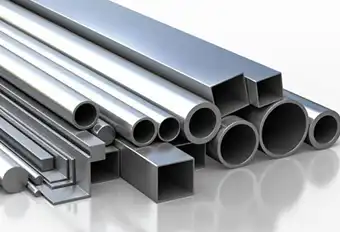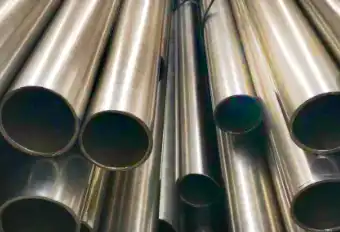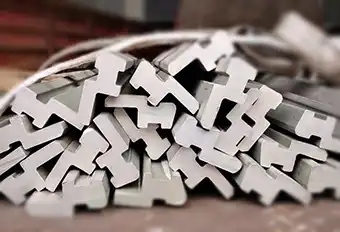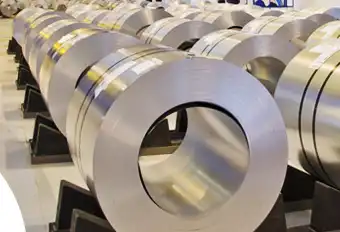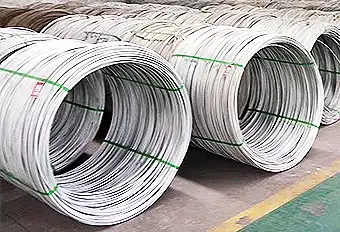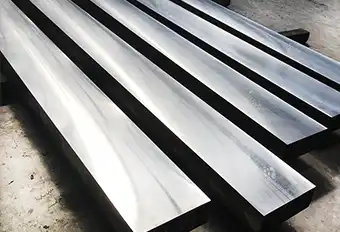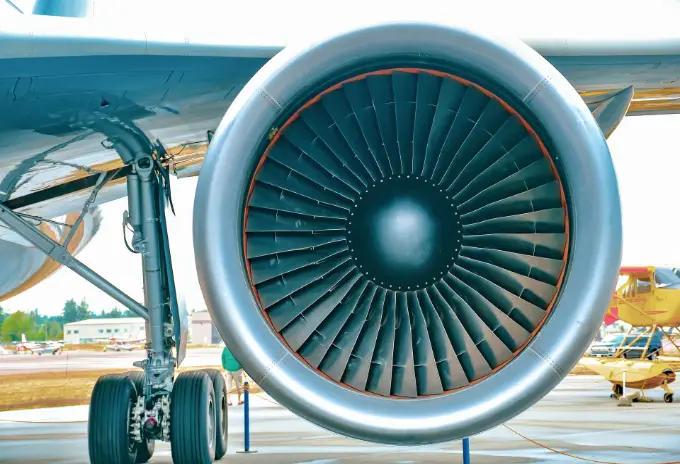Stainless steels are iron-based alloys containing at least 10.5%
Cr. Few stainless steels contain more than 30%
Cr or less than 50%
Fe. They achieve their stainless characteristics through the formation of an invisible and adherent chromium-rich oxide surface film. This oxide forms itself in the presence of oxygen.
Other elements added to improve characteristics include nickel, molybdenum, copper, titanium, aluminum, silicon, niobium, nitrogen, sulfur, and selenium. Carbon is normally present in amounts ranging from less than 0.03% to over 1.0% in certain martensitic grades.
The selection of stainless steels may be based on corrosion resistance, fabrication characteristics, availability, mechanical properties in specific temperature ranges and product cost. However, corrosion resistance and mechanical properties are usually the most important factors in selecting a grade for a given application.
Stainless steels are commonly divided into five groups: martensitic stainless steels, ferritic stainless steels, austenitic stainless steels, duplex (ferritic-austenitic) stainless steels, and precipitation-hardening stainless steels.
The development of precipitation-hardenable stainless steels was spearheaded by the successful production of Stainless W by U.S. Steel in 1945. The problem of obtaining raw materials has been a real one, particularly in regard to nickel during 1950s when civil wars raged in Africa and Asia, prime sources of nickel, and Cold War politics played a role because Eastern-bloc nations were also prime sources of the element. This led to the development of a series of alloys (AISI 200 type) in which manganese and nitrogen are partially substituted for nickel. These stainless steels are still produced today.
Over the years, stainless steels have become firmly established as materials for cooking utensils, fasteners, cutlery, flatware, decorative architectural hardware, and equipment for use in chemical plants, dairy and food-processing plants, health and sanitation applications, petroleum and petrochemical plants, textile plants, and the pharmaceutical and transportation industries. Some of these applications involve exposure to either elevated or cryogenic temperatures; austenitic stainless steels are well suited to either type of service.
Modifications in composition are sometimes made to facilitate production. For instance, basic compositions are altered to make it easier to produce stainless steel tubing and casting. Similar modifications are made for the manufacture of stainless steel welding electrodes; here combinations of electrode coating and wire composition are used to produce desired compositions deposited weld metal.
Martensitic stainless steels are essentially alloys of chromium and carbon that possess a distorted body-centered cubic (bcc) crystal structure (martensitic) in the hardened condition. They are ferromagnetic, hardenable by heat treatments, and are generally resistant to corrosion only to relatively mild environments. Chromium content is generally in the range of 10.5 to 18%, and carbon content may exceed 1.2%. The chromium and carbon contents are balanced to ensure a martensitic structure after hardening.
General corrosion is often much less serious than localized forms such as stress corrosion cracking, crevice corrosion in tight spaces or under deposits, pitting attack, and intergranular attack in sensitized material such as weld heat-affected zones (HAZ). Such localized corrosion can cause unexpected and sometimes catastrophic failure while most of the structure remains unaffected, and therefore must be considered carefully in the design and selection of the proper grade of stainless steel.
Corrosive attack can also be increased dramatically by seemingly minor impurities in the medium that may be difficult to anticipate but that can have major effects, even when present in only part-per-million concentrations; by heat transfer through the steel to or from the corrosive medium; by contact trimmed only on the ends.
Stainless steels are available in the form of plate, sheet, strip, foil, bar, wire, semi-finished products, pipes, tubes, and tubing.
Sheet
Sheet is a flat-rolled product in coils or cut lengths at least 610 mm wide and less than 4.76 mm thick. Stainless steel sheet is produced in nearly all types except the free machining and certain martensitic grades. Sheet from the conventional grades is almost exclusively produced on continuous mills. Hand mill production is usually confined to alloys that cannot be produced economically on continuous mills, such as certain high-temperature alloys.
The steel is cast in ingots, and the ingots are rolled on a slabbing mill or a blooming mill into slabs or sheet bars. The slabs or sheet bars are then conditioned prior to being hot rolled on a finishing mill. Alternatively, the steel may be continuous cast directly into slabs that are ready for hot rolling on a finishing mill. The current trend worldwide is toward greater production from continuous cast slabs.
Sheet produced from slabs on continuous rolling mills is coiled directly off the mill. After they are descaled, these hot bands are cold rolled to the required thickness and coils off the cold mill are either annealed and descaled or bright annealed. Belt grinding to remove surface defects is frequently required at hot bands or at an intermediate stage of processing. Full coils or lengths cut from coils may then be lightly cold rolled on either dull or bright rolls to produce the required finish. Sheet may be shipped in coils, or cut sheets may be produced by shearing lengths from a coil and flattening them by roller leveling or stretcher leveling.
Strip
Strip is a flat-rolled product, in coils or cut lengths, less than 610 mm wide and 0.13 to 4.76 mm thick. Cold finished material 0.13 mm thick and less than 610 mm wide fits the definitions of both strip and foil and may be referred to by either term.
Cold-rolled stainless steel strip is manufactured from hot-rolled, annealed, and pickled strip (or from slit sheet) by rolling between polished rolls. Depending on the desired thickness, various numbers of cold rolling passes through the mill are required for effecting the necessary reduction and securing the desired surface characteristics and mechanical properties.
Hot-rolled stainless steel strip is a semi-finished product obtained by hot-rolling slabs or billets and is produced for conversion to finished strip by cold rolling.
Heat Treatment. Strip of all types of stainless steel is usually either annealed or annealed and skin passed, depending on requirements. When severe forming, bending, and drawing operations are involved, it is recommended that such requirements be indicated so that the producer will have all the information necessary to ensure that he supplies the proper type and condition. When stretcher strains are objectionable in ferritic stainless steels such as type 430, they can be minimized by specifying a No 2 finish. Cold-rolled strip in types 410, 414, 416, 420, 431, 440A, 440B, and 440C can be produced in the hardened and tempered condition.
Experience in the use of stainless steels indicates that many factors can affect their corrosion resistance. Some of the more prominent factors are:
- Chemical composition of the corrosive medium including impurities
- Physical state of the medium-liquid, gaseous, solid, or combinations thereof
- Temperature
- Temperature variations
- Aeration of the medium
- Oxygen content of the medium
- Bacteria content of the medium
- Ionization of the medium
- Repeated formation and collapse of bubbles in the medium
- Relative motion of the medium with respect to the steel
- Chemical composition of the metal
- Nature and distribution of microstruc-tural constituents etc.
Surface Finish. Other characteristics in the stainless steel selection checklist are vital for some specialized applications but of little concern for many applications. Among these characteristics, surface finish is important more often than any other except corrosion resistance. Stainless steels are sometimes selected because they are available in a variety of attractive finishes. Surface finish selection may be made on the basis of appearance, frictional characteristics, or sanitation.
Plate
Plate is a flat-rolled or forged product more than 250 mm (10 in.) in width and at least 4.76 mm (0.1875 in.) in thickness. Exceptions include highly alloyed ferritic stainless steels, some of the martensitic stainless steels, and a few of the free-machining grades. Plate is usually produced by hot rolling from slabs that have been directly cast or rolled from ingots and that usually have been conditioned to improve plat surface. Some plate may be produced by direct rolling from ingot.
For strip, edge condition is often more important than it usually is for sheet. Strip can be furnished with various edge specifications:
- Mill edge (as produced, condition unspecified)
- No.1 edge (edge rolled, rounded, or square)
- No.3 edge (as slit)
- No.5 edge (square edge produced by rolling or filing after slitting)
Foil
Foil is a flat-rolled product, in coil form, up to 0.13 mm thick and less than 610 mm wide. Foil is produced in slit widths with edge conditions corresponding to No.3 and No.5 edge conditions for strip. Foil is made from types 201, 202, 301, 302, 304, 304L, 305, 316, 316L, 321, 347, 430, and 442, as well as from certain proprietary alloys.
The finishes, tolerances, and mechanical properties of foil differ from those of strip because of limitations associated with the way in which foil is manufactured. Nomenclature for finishes, and for width and thickness tolerances, vary among producers.
Mechanical Properties. In general, mechanical properties of foil vary with thickness. Tensile strength is increased somewhat, and ductility is lowered, by a decrease in thickness.
Bar
Bar is a product supplied in straight lengths; it is either hot or cold finished and is available in various shapes, sizes, and surface finishes. This category includes small shapes whose dimensions do not exceed 75 mm and, second, hot-rolled flat stock at least 3.2 mm thick and up to 250 mm wide.
Hot-finished bar is commonly produced by hot rolling, forging, or pressing ingots to blooms or billets of intermediate size, which are subsequently hot rolled, forged, or extruded to final dimensions.


